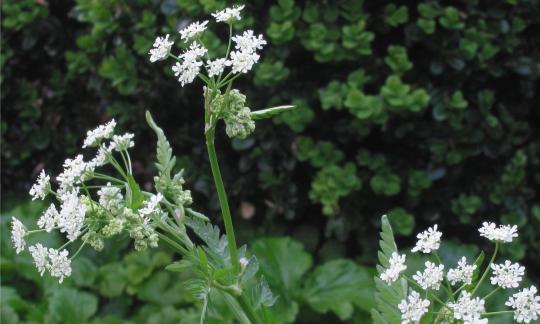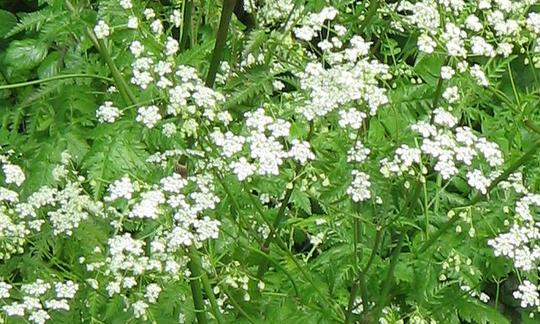Table of contents
Cow parsley ( Anthriscus sylvestris ) is a dominant feature of Central European meadows, especially in spring. An important clue for identifying the food plant is the carrot aroma, which is strongly noticeable when the leaves are rubbed and can prevent confusion with very poisonous lookalikes.
Use in the kitchen
Is cow parsley poisonous? Cow parsley (or cow chervil) is not poisonous, you can basically eat it and use it in many ways in the kitchen.
What does chervil taste like? The basic taste of cow parsley is reminiscent of a mixture of carrot, parsley, anise and caraway . The roots have a delicate, spicy taste. Overall, cow parsley has a slightly more bitter taste than common chervil ( Anthriscus cerefolium ). Since chervil is one of the first plants to be harvested in spring, it is a traditional ingredient in spring Easter dishes.
What do you season with chervil? Leaf sprouts are used for salads, raw vegetables, wild plant lemonades and punch. Tender leaves can be added raw or warm to vegetable dishes, vegetable strudel, oven-baked vegetables, pickles or spinach. Finely chopped, cow parsley enriches vegetable soups, chopped herb mixtures, sauces, patties or bread dough. 1
The fully blossomed umbel flowers are used as raw edible decoration or to flavor drinks and food. They are suitable as a seasoning in wild herb salt, herb oil or herb vinegar. The flowers can be candied, made into spice sorbet or dipped in sweetened batter and baked. 1
Buds are aromatic and very soft. They can be used in dishes and seasoning pastes. 1 The ripe seeds are suitable as a spice and add flavour to wine, spirits and bread dough. When germinated, they are a source of vitamins, e.g. in winter. 1 The roots of young plants can be grated directly into a salad or used in vegetable dishes and soups. The aroma of the roots is spicy, similar to parsnip root . 1
Is chervil a Maggi herb? Chervil is not a Maggi herb. Lovage is often referred to as a Maggi herb.
Vegan recipe for green pesto with cow chervil
Ingredients: For a small jar of pesto you need 20 g (roasted) pine nuts, 50 g (roasted) macadamia nuts, 30 g fresh chervil leaves (organic), 50 ml olive oil (or healthier, cold-pressed rapeseed oil ), 1 tbsp fresh lemon juice and a little salt .
Preparation: Mix all ingredients in a high-performance blender until you reach the desired consistency. Cow parsley pesto goes well with boiled potatoes, rice, fresh asparagus or simply on bread .
Cow Parsley Tea
Cow parsley tea was used for medicinal purposes in the late Middle Ages. Today, tea preparations with cow parsley are no longer common.
| Not only vegans or vegetarians should read this: Vegans often eat unhealthily. Avoidable nutritional errors . |
Purchasing - Storage
Cow parsley can be bought as seedlings or seeds online or in specialist shops. The availability of cow parsley seeds varies depending on the size of the shop, catchment area, etc. Also available is the purple cow parsley 'Ravenswing', a noble cultivated form with bronze-black foliage; the flowers are classically white.
We have not yet found any cow chervil in supermarkets such as Coop, Migros, Denner, Volg, Spar, Aldi, Lidl, Rewe, Edeka, Billa or Hofer, nor in the organic supermarkets Denns and Alnatura .
Cow
parsley can be found in the wild in Central and Northern Europe on the edges of forests, in bushes, on verges, embankments and fallow land. The wild plant prefers to grow on nutrient-rich soils. Cow parsley is found in large numbers on over-fertilized meadows and forms a stand. 2
What does cow parsley look like? Cow parsley is an herbaceous plant and reaches heights of 60 to 120 centimeters. The stem is grooved and hollow. The leaves are two to three times pinnate, about 15 to 30 centimeters long and have a triangular outline. The young leaves smell of carrot and anise when rubbed.
How does chervil bloom? The inflorescence is an umbel, which means that many branches branch off from a first branching point. Cow parsley lacks bracts. 1 These are the small bracts directly under the umbel. Further up, branches branch off from a point, hence the name "double umbel". These smaller groups of flowers, called "umbels", have fringed sheaths on the edge under the branching points.
Before the flower stalk shoots up in spring, you can harvest the tender, very aromatic shoots. The first leaf shoots are plucked from March to April. The main flowering period is from April to August. The season for harvesting the leaves is before the flowering period. After that, the bitter substance content in the leaves increases. However, young, tender leaves can be plucked all year round. The budding flower heads are harvested in May and the fully blossomed flower plates from June to August. The ripe fruits are collected from July to September. The root harvest of young chervil plants begins in September and lasts until winter. 1
Cow parsley can be confused with highly poisonous plant species from the Apiaceae family. You can find detailed explanations below under "Risk of confusion".
If you don't want to take any risks when identifying wild cow parsley, it's best to buy seeds and plant chervil as a pot plant. Another option is to take part in a guided herb walk, where you explore chervil locations and then visit them again and again to harvest.
Storage tips
It is best to use the leaves of the cow parsley fresh. You can place generously cut parts of the plant in a glass of water for a few days to keep them fresh. If you want to keep chervil for longer, you should freeze the leaves rather than dry them to preserve the aroma. 4
Dried cow parsley should be stored airtight and protected from light in well-sealable containers made of glass or metal.
Ingredients - Nutritional values - Calories
The nutritional tables refer to common chervil . This is particularly rich in vitamin A. The ingredients of meadow chervil may be comparable to those of common chervil.
You can find all the ingredients, the coverage of the daily requirement and comparison values with other ingredients in our nutrient tables. In the article Nutrients explained you will get a detailed insight into the topic.
Health Effects
Cow parsley is rich in active ingredients that are potentially useful in the treatment of cancer and inflammatory diseases.
Secondary plant substances
The phytochemical composition of the fresh and dried leaves, flowers, fruits and roots of cow parsley has been demonstrated in several studies. A total of 41 compounds were identified in the above-ground parts of the plant. 7
Our article on secondary plant substances provides an overview of the classification of substance groups, their occurrence in food and possible effects on humans. Cow parsley contains the following secondary plant substances: 1,7,8
- Isoprenoids: monoterpenes (beta-phellandrene, beta-myrcene, sabinene, Z-beta-ocimene, alpha-pinene) and monoterpenoids; sesquiterpenes (beta-elemene, alpha-zingiberene, (E)-caryophyllene, germacrene-D); triterpenes: steroids (alpha-sitosterol,beta-sitosterol ); tetraterpenes ( carotenoids )
- Polyphenols: Phenolic acids: hydroxycinnamic acids (chlorogenic acid); flavonoids: flavonols (quercetin, isoquercetin, rutin), anthocyanins, flavones (apigenin, isoquercetin), flavanoid glycosides (cynarosin), isoflavones (daidzin, daidzein, genistin, sissotrin, formonentin), lignans (anthricin, anthriscusin, anhydropodorhizol, alpha-peltatin, arctigenin, beta-peltatin, dimethylmatairesinol, dimethylthujaplicatin, epipodophyllotoxin, hinokinin, 7-hydroxyyatein, 7-hydroxy-anhydropodorhizol, isopicropodophyllone, lariciresinol, morelensin, nemerosin, podophyllotoxin, secoisolariciresinol, yatein)
- Other organic compounds: Phenylpropanoids (1-3′-methoxy-4′,5′-methylenedioxyphenyl-1-methoxy-2-propene, elemicin, eugenol); coumarins (scopoletin, isoscopoletin, bergapten, furocoumarin); aldehydes; alcohols (benzyl alcohol, 2-phenyl alcohol, falcarindiol, falcarindiol-3-acetate, saligenol)
However, it should be noted that the composition of the secondary plant substances in cow parsley can vary depending on the variety, time of harvest and growing conditions. Therefore, quantities are only of limited use and should only be understood roughly.
Chervil species contain essential oils that determine their taste (including monoterpenes), phenolic acids, flavonoids, lignans, phenylpropanoids, coumarins and alcohols. The chemical profile of the essential oil in the leaves and roots of cow parsley differs only slightly. The oil from the roots consists of 69% monoterpenes with the main components β-phellandrene (45.5%), Z-β-ocimene (16.9%) and α-pinene (4.6%). In the oil from the above-ground parts of the plant, the monoterpene fraction also represents the main component at 70%. The main components are β-phellandrene (38.8%), β-myrcene (16.7%), sabinene (6.2%) and (Z)-β-ocimene (5.4%). 7
The fruits contain the four lignans anthricin (deoxypodophyllotoxin), yatein, morelensin and hinokinin. The latter two lignans were not detected in the roots. The content of lignans in the above-ground parts of the cow parsley is significantly lower than in the roots. Environmental factors have a strong influence on the lignan profile and content. At higher altitudes, the content of deoxypodophyllotoxin is significantly higher in all parts of the plant. In the above-ground parts of the plant, 0.13% deoxypodophyllotoxin was measured at a growth height of 900 m and 0.33% at 1200 m, and in the roots 0.38% at 900 m and 0.78% at 1200 m. 7
The main active ingredient and most important component of cow parsley is the lignan anthricin, which is mainly isolated from the roots. The diverse bioactivities of lignans have been known for a long time. Studies have shown anti-cancer (antitumor), anti-inflammatory and growth-inhibiting (antiproliferative), antibacterial, antiviral, antiasthmatic, antipyretic, analgesic, liver-protective, antiallergic, cartilage-protective and anti-thrombosis effects for the active ingredient deoxypodophyllotoxin and for aqueous extracts of cow parsley. 7,8,9,10,11,12
Anthricin can be used as a precursor for the synthesis of epipodophyllotoxin, the starting material for the cancer drugs etoposide and teniposide. 7,13
As a source of lignan derivatives and flavonoid compounds, cow parsley could play a role in the production of medicines in the future. Lignans are among the best studied substances due to their anti-cancer activity. 7
Antitumor: Nine lignan compounds were isolated from the roots of cow parsley and their antitumor activity was tested against HepG2 (human hepatocellular carcinoma), MG-63 (human osteosarcoma), B16 melanoma cells and HeLa cancer cells (human cervical carcinoma). Two of the compounds showed strong inhibitory activities, two others showed weaker inhibition and other compounds were weakly anticancer. 8
Antimicrobial: In studies, anthricin showed a significant antimicrobial effect against Staphylococcus aureus and Helicobacter pylori, but not against Escherichia coli . In addition, the active ingredient proved to be a highly effective and selective inhibitor against herpes simplex virus types (HSV-1 and HSV-2). In contrast, anthricin was found to have no antiviral effect against the influenza A virus, the respiratory syncytial virus (RSV) or the human cytomegalovirus (HCMV). 7
Antioxidant: The antioxidant properties have been demonstrated with both crude extracts and isolated compounds. The most important antioxidants in cow parsley are quercetin, apigenin and rutin. 7
Dangers - Intolerances - Side effects
Contact with cow parsley can cause phytotoxic reactions on the skin in sensitive people, known as meadow dermatitis. Because of its bitter substances, caution is advised during pregnancy or abstinence is advised.
When collecting cow parsley from the wild, the risk of confusion with highly poisonous counterparts should not be underestimated. You can find more information in the "Risk of confusion" section.
Danger of confusion
When collecting cow parsley, there is a considerable risk of confusion with other, sometimes highly poisonous plant species from the Umbelliferae family. This poses a risk not only to humans, but also to all domestic animals such as horses and rabbits.
Edible species include chervil ( Anthriscus cerefolium ), wild carrot ( Daucus carota subsp. carota ), caraway ( Carum carvi ), parsnip ( Pastinaca sativa ), ground elder ( Aegopodium podagraria ) and dill ( Anethum graveolens ).
Poisonous Umbelliferae are cow parsnip ( Heracleum sphondylium ), hedge goiter ( Chaerophyllum temulum ) and broad-leaved merk ( Sium latifolium ). Highly poisonous plants include spotted hemlock ( Conium maculatum ), fool's parsley ( Aethusa cynapium ) and water hemlock ( Cicuta virosa ).
If you want to harvest cow parsley, you should know the plant and its poisonous counterparts very well, as confusion can be fatal. Profiles and pictures of cow parsley and related species are helpful for precise identification.
All parts of the hemlock ( Conium maculatum ) plant are highly poisonous. The poisonous alkaloids are most concentrated in the unripe seeds. Around 50 g of the fresh plant are fatally poisonous. When picked, even uninjured skin can absorb the poison. In the past, hemlock was used medicinally, but today it is rarely used in ointments for inflammation and nerve pain or in homeopathy. Poisoning initially manifests itself as a burning sensation in the mouth, followed by vomiting and paralysis, and ultimately death. As a countermeasure, immediate vomiting should be induced. Another clinical measure is ventilation. Important distinguishing features are the unpleasant smell of the poisonous plant, the bluish stems, five to six bracts (directly under the umbel) and the absence of a root tuber. 1
Fool's parsley ( Aethusa cynapium ) is a highly poisonous plant with poisonous ingredients throughout the plant. Fatal cases of poisoning are only known from old literature sources. Poisoning with fool's parsley can be recognized by a burning sensation in the mouth, vomiting, cold sweat, pale skin, rapid pulse, cramps, visual disturbances and dilated pupils. Countermeasures include inducing vomiting or gastric lavage. An important distinguishing feature is the unpleasant smell of fool's parsley. The bracts (leaves under the umbel flower) consist of three leaves that are arranged on one side. 1
The toxins of water hemlock ( Cicuta virosa ) are distributed throughout the plant. Particularly large amounts are found in the stems and the rhizome. After about 20 minutes, the first signs of poisoning appear, starting with a burning sensation in the mouth. Other symptoms include nausea, vomiting, cramps and shortness of breath. As a countermeasure, vomiting should be induced. Clinical treatment of the cramps that occur is necessary. Important distinguishing features are the lack of a root tuber, the finger-shaped leaves and the umbel with up to 25 branches. Caution: The rhizome smells of celery and tastes like parsnip or parsley root. 1
Use as a recognized medicinal plant
Cow parsley does not currently have any recognized medical uses according to HMPC ( Committee on Herbal Medicinal Products ), ESCOP ( Association of National European Societies for Phytotherapy ) or Commission E ( Expert Commission on Herbal Medicinal Products ).
The above-mentioned institutions, with their monographs, form an important basis for assessing the medical use of medicinal plants as well as for the approval process for herbal medicinal products.
Folk medicine - natural healing
Chervil was used in ancient times as a spice and medicinal plant. In late medieval monastic medicine, chervil tea was used for liver diseases, kidney stones, loss of appetite and digestive problems.
Chervil is now popularly used as a tonic for spring cures. Plant extracts taken internally are said to help with rheumatism and jaundice. A paste made from fresh chervil can be used externally for eczema, skin inflammation, conjunctivitis, inflamed eyelids and hemorrhoids. 1,4
In folk medicine, chervil is said to have diuretic and diaphoretic properties as well as digestive, blood-purifying and antioxidant effects. 1,4
Ecological footprint - animal welfare
The ecological footprint of chervil depends on many factors, see our ingredient True chervil (garden chervil) .
In conventional agriculture, synthetic pesticides and herbicides are often used to control pests. However, these also have a negative impact on the surrounding ecosystem 6 and affect birds, fish, insects (such as important pollinators), but also humans. 5 When buying seeds and seedlings, look for organic cow parsley, as this does not use such pesticides.
The flowering period of the cow parsley is from April to August/September. The flowers, which are "nectar-bearing disc flowers" in terms of flower ecology, offer a rich early summer to early autumn nectar. The flower visitors include insects of all kinds, especially hoverflies and beetles. Nectar is the general term for the food that the bees bring in, i.e. nectar, pollen and honeydew. The nectar value of the cow parsley is high and the pollen value is medium (nectar value and pollen value scale: none, low, medium, high, very high). 1.2
For detailed explanations of various sustainability indicators (such as ecological footprint, CO2 footprint, water footprint), see our article: What does the ecological footprint mean?
Worldwide occurrence - cultivation
Chervil probably came to Northern and Central Europe through the Romans, where the plant has been cultivated since the Middle Ages. Cow parsley is widespread in Central and Northern Europe, but rather rare in Southern Europe. 2
Farmers are fighting cow parsley on agricultural land because the older plants in particular are of inferior quality for animal feed and at the same time displace more valuable meadow plants.
Cultivation - Harvest
Sowing of cow parsley takes place from spring to autumn. As a cold germinator, cow parsley can also be sown in winter. As the seeds germinate in light, they are not covered with soil. The seeds are viable for about a year. 4
The soil should be nutrient-rich, light and moisture-retaining and the location should be semi-sunny to semi-shaded. In order to be able to harvest in winter, cow parsley should be grown in cool regions under fleece, under foil or in a box. In high temperatures and with a lot of sun, chervil tends to bolt. Chervil protects lettuce from ants, aphids and snails. 4
In the wild plant garden, the non-invasive cow parsley is suitable, for example, in combination with stinging nettle, meadowsweet, comfrey, wild garlic, woodruff, burnet, meadowfoam, marigolds or sweet violets.
As a pot plant, you can grow cow parsley with other shade-loving herbs such as lemon balm, peppermint, parsley, chives, lovage or dill .
Further information
The cow parsley ( Anthriscus sylvestris ) is a plant species from the genus chervil ( Anthriscus ) and belongs to the family of the umbelliferae (Apiaceae). Among the Central European umbelliferae, the cow parsley flowers the earliest. The cow parsley is the most widespread and used species of this genus. 1
The chervil plant genus includes 9 to 15 species that are widespread in Eurasia and Africa. In addition to the cow parsley, the common chervil is also known (often referred to as garden chervil). Its cultivated form , Anthriscus cerefolium var. cerefolium, is also popular as a soup herb and as a spice for vegetables or salads. Overall, the common chervil is slightly smaller 3 and has finer leaves than the cow parsley.
Alternative names
There are numerous, regionally used alternative names for the meadow chervil (meadow chervil) such as Bange, Bäumlikraut, Buchholder, Buggla, Buschmoren, Cherbel, Chrabella, Emtstengel, Eselskörbel, Eselspeterlein, Feine Scherre, Hartkopf, Hartkopp, Heustengel, Hingstwäid, Hundekümmel, wilder Ibarach, Kälberkerner, Kalberkropf, Kälberrohr, Kälberscheere, Kälberscheiss, Kalbarkrop, Kalverkropp, Kelberkern, Kirbel, Kirbelstengel, Kocker, wilder Körffel, Korbelkom, Krabellen, Krebellen, Kreblikraut, Kruud, Kuhpeterlein, Ledepipenkrud, Ledespypenkrut, Leiterlikraut, Paguda, Pferdskümmel, Piffenkrut, Pigudabengel, Pipencrud, Ramschfedern, Rosskümmel, Schärläch, Scharnpiepen, Scharpenpiepen, Schere, Tigerlikraut, Tschickan, Waterweed, Windrose, Wolfsroot and Zieger.
In English, cow chervil is called wild beaked parsley, woodland chervil, keck, cow parsley, wild chervil, Queen Anne's lace or woodland beak chervil.
Bibliography - 13 Sources (Link to the evidence)
| 1. | Fleischhauer SG, Guthmann J, Spiegelberger R. Enzyklopädie. Essbare Wildpflanzen. 2000 Pflanzen Mitteleuropas. 1. Auflage. Aarau; 2013. AT Verlag. |
| 2. | Kremer BP. Mein Garten – Ein Bienenparadies. 2. Auflage. Bern; 2018. Haupt Verlag. |
| 3. | Oberdorfer E. Pflanzensoziologische Exkursionsflora für Deutschland und angrenzende Gebiete. 8. Auflage. Stuttgart: Ulmer; 2001: 702. |
| 4. | Bown D. Kräuter. Die grosse Enzyklopädie. Anbau und Verwendung. 2. Auflage. München; 2015. Dorling Kindersley. |
| 5. | Hernandez AF, Parron T, Tsatsakis AM et al. Toxic effects of pesticide mixtures at a molecular level: Their relevance to human health. Toxicology. 2013;307:136-145. |
| 6. | Sharma A, Kumar V, Shazad B et al. Worldwide pesticide usage and its impacts on ecosystem. SN Applied Sciences. 2019. |
| 7. | Olaru O et al. Ethnomedicinal, Phytochemical and Pharmacological Profile of Anthriscus sylvestris as an Alternative Source for Anticancer Lignans. Molecules. 2015;20:15003-15022. |
| 8. | Chen H et al. Antitumor constituents from Anthriscus sylvestris (L.) Hoffm. Asian Pac J Cancer Prev. 2014;15(6):2803-2807. |
| 9. | Kim SB, Lee AY et al. Anthriscus sylvestris root extract reduces allergic lung inflammation by regulating "interferonregulatoryfactor" 4-mediated Th2 cell activation. Journal of Ethnopharmacology. March 2019;232:165–175. |
| 10. | Kim KY, Park KI et al. Deoxypodophyllotoxin in Anthriscus sylvestris alleviates fat accumulation in the liver via AMP-activated protein kinase, impeding SREBP-1c signal. Chem Biol Interact. October 2018;294:151-157. |
| 11. | Lee SA, Moon SM et al. In Vivo and In Vitro Anti-Inflammatory Effects of Aqueous Extract of Anthriscus sylvestris Leaves. J Med Food. 2018;21(6):585-595. |
| 12. | Lee SA, Moon SM et al. Chondroprotective effects of aqueous extract of Anthriscus sylvestris leaves on osteoarthritis in vitro and in vivo through MAPKs and NF-κB signaling inhibition. Biomed Pharmacother. July 2018;103:1202–1211. |
| 13. | Seegers CLC, Tepper PG et al. Cytotoxic Deoxypodophyllotoxin Can Be Extracted in High Purity from Anthriscus sylvestris Roots by Supercritical Carbon Dioxide. Planta Med. May 2018;84(8):544–550. |










Comments